Today is the last day of February! I will actually miss this post-a-day project, though I will be happy to take a day or two break.
Today’s author is an online heart friend I met after she found my blog in its early days. We later discovered we have much in common: being mom to boys, having HELLP syndrome with our first babies, running, biking, and a need to live heart healthy. Lynn has made plant-based eating a priority in her family’s life and I’m so happy she wanted to share some of what she learned with us here.
Choosing the best CSA, and using it wisely
by Lynn Lascola
Our family began 2012 with the decision to eat a low-fat vegetarian diet at home. This would mean an entirely different way of cooking and eating for all of us. I had heard about CSA before from friends but hadn’t paid too much attention to details because I didn’t think it would be something our family would be interested in. However, now that our family was eating such a greater volume of fresh produce, this now sounded like something to investigate.
What is CSA?
 Community Supported Agriculture (CSA) consists of a community of individuals who pledge support to a farm operation so that the farmland becomes, either legally or spiritually, the community’s farm, with the growers and consumers providing mutual support and sharing the risks and benefits of food production.
Community Supported Agriculture (CSA) consists of a community of individuals who pledge support to a farm operation so that the farmland becomes, either legally or spiritually, the community’s farm, with the growers and consumers providing mutual support and sharing the risks and benefits of food production.
Typically, members or “share-holders” of the farm or garden pledge in advance to cover the anticipated costs of the farm operation and farmer’s salary. In return, they receive shares in the farm’s bounty throughout the growing season, as well as satisfaction gained from reconnecting to the land and participating directly in food production.
Members also share in the risks of farming, including poor harvests due to unfavorable weather or pests. By direct sales to community members, who have provided the farmer with working capital in advance, growers receive better prices for their crops, gain some financial security, and are relieved of much of the burden of marketing.
How do I find CSA in my area?
First of all – ask around! Find out if any of your friends or neighbors are participating or have participated in CSA. This website also has a great search feature: http://www.localharvest.org/csa/.
You may have several options available to you. I recommend asking to see photos of what past weekly shares look like. How many different kinds of vegetables and fruits (or other items) will be in each weekly share? Do I get any choice – or it it all farmers choice? Are there different share sizes available? (Some farms only offer one share size while others will offer 3 or 4 sizes.) If only one size is available, you may want to find a friend to split a share with.
How I made my CSA decision
I decided CSA would be a good idea for my family for several reasons. First of all, I knew it would challenge me to incorporate more vegetables and a greater variety of vegetables into our diet. I also thought it would be a wonderful way to support my local economy by directly supporting the farmers in my area. The environmentalist in me also loved that purchasing produce this way has such a positive affect on the environment as eating locally reduces the emissions given off by all the trucks, planes, and ships that transport produce all over the world to our grocery stores. It’s eating the old fashioned way — by eating what’s ripe and available locally at the time. Finally, I knew we’d be getting fresh picked, nutrient-rich produce by participating in CSA.
We live in an area that has a number of farms with CSA programs nearby. After some investigation, I chose the farm closest to my home and one that had a delivery spot just a few minutes drive from my home (closer than any grocery store!).
I also liked that the farm I chose was certified organic. Their program is “value added” which meant each member usually receives six different vegetables, two different fruits, a dozen eggs, and a loaf of fresh bread. At pickup, each member chooses (quantity stated by the farmer) their produce items and has the option to trade one item in for something else that they’d rather have. (Some farms don’t have any flexibility, i.e. you just get what you’re given and that’s it, while others are very flexible and let you choose every item you’d like from a list of many.)
The good and the bad
 There definitely is a learning curve to participating in CSA. You need to be committed to eating most of your meals at home and trying new recipes to incorporate new vegetables — some of which you likely have never purchased before. I struggled with this at first and there definitely were vegetables that ended up getting composted in my yard rather than eaten (it still happens occasionally).
There definitely is a learning curve to participating in CSA. You need to be committed to eating most of your meals at home and trying new recipes to incorporate new vegetables — some of which you likely have never purchased before. I struggled with this at first and there definitely were vegetables that ended up getting composted in my yard rather than eaten (it still happens occasionally).
One thing I learned is to freeze what you don’t think you’ll eat that week. For many months after our CSA share ended, I still enjoyed grabbing frozen (and chopped!) veggies out of my fridge and adding them to meals. Another tip would be to get a Vita-Mix. I use ours everyday to quickly whip up smoothies using the vegetables from our share into a tasty drink the entire family enjoys (and I feel so good about serving them!). None of my guys will eat kale … but they’ll happily gulp it down every morning in a tasty smoothie!
 Lynn Lascola lives in Maryland with her husband and three boys. She is a triathlete (as is her husband), and her boys compete too! Her family went plant-based in 2012 and she started her blog, Low Fat Veggie Family, to share recipes and tips in 2013.
Lynn Lascola lives in Maryland with her husband and three boys. She is a triathlete (as is her husband), and her boys compete too! Her family went plant-based in 2012 and she started her blog, Low Fat Veggie Family, to share recipes and tips in 2013.



Recent Comments